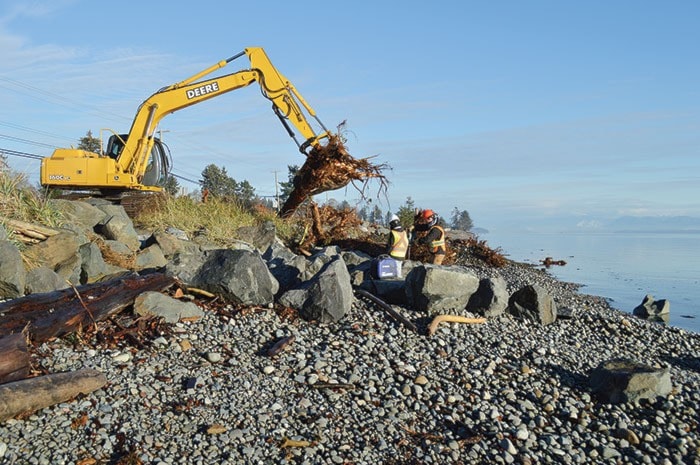Those aren’t totem poles lined up at Stories Beach.
Rather, they’ll become bird houses and natural storm breaks as part of an innovative pilot project by the Ministry of Transportation.
“We’re not building a big, high wall to keep the ocean in – this is definitely more of a green shore,” said Sean Wong, a senior biologist with the ministry.
Wong, along with a team of three people and one equipment operator, began work last week to stabilize about 200 metres of beachfront that borders the Island Highway.
The original plan was to spend about $100,000 to put in riprap and create a more level beach which could help mitigate storm damage to the highway.
But as Wong points out, that usually means the effects of damaging storms are pushed further along the beach, typically in the direction of the prevailing wind and tide. In this case, that would be north there’s a stream, property and homes.
The rip-rap look is also so 1970s when the engineering rule of thumb was “controlling nature” with as much concrete as possible.
But Stories Beach will be different, says Wong, who adds the project has the approval of Fisheries and Oceans Canada. With a budget of approximately $25,000 – one-quarter of the original plan – he’s brought in logs and stumps from forestry burn piles, and has used existing driftwood, to stabilize the beach while maintaing a far more natural look.
“Our goal is to mimic the natural beachfront – we’re trying to avoid a sterile, non-natural look,” he says.
The process is relatively simple: They first drill through large rocks; loop steel cable through the holes; use the excavator to embed the rocks as much as possible in the beach; and then secure the stumps and woody debris to the cables. After that, nature takes over. Waves will drive smaller debris and gravel up behind the secured wood, to create backfill and a far more stable beach.
Wong is also paying attention to aesthetics. Natural plants and grasses have been planted throughout the work zone along with some trees.
As for the standing timber, not only will they help block flying driftwood during the big winter storms, they also have cutouts to provide homes for nesting birds. Another contractor, from the Oyster River Enhancement Society, is also making bird houses for purple martins whose numbers are rebounding on the coast thanks to conservation efforts.
“In the 1980s they were down to like five breeding pairs. Now they’re up to 950!” Wong points out as he surveys the beach work. “We want to mimic the natural features and promote stability. Artificial solutions typically transfer the problem down the line – and harder treatments, like concrete walls and riprap, have more impact on the environment and native species.”
This is a pilot project for the ministry on Vancouver Island, and Wong hopes there are more opportunities to do the same type of work elsewhere. He does have one request though for wood stove owners: Please do not cut any more logs or driftwood on Stories Beach.
“That would just destabilize things,” he says.
